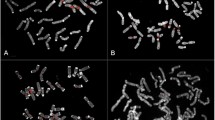Summary
The centromeric regions of human chromosomes are characterized by diverged chromosome-specific subsets of a tandemly repeated DNA family, alpha satellite, which is based on a fundamental monomer repeat unit ∼ 171 bp in length. We have compared the nucleotide sequences of 44 alphoid monomers derived from cloned representatives of the multimeric higher-order repeat units of human chromosomes 1, 11, 17, and X. The 44 monomers exhibit an average 16% divergence from a consensus alphoid sequence, and can be assigned to five distinct homology groups based on patterns of sequence substitutions and gaps relative to the consensus. Approximately half of the overall sequence divergence can be accounted for by sequence changes specific to a particular homology group; the remaining divergence appears to be independent of the five groups and is randomly distributed, both within and between chromosomal subsets. The data are consistent with the proposal that the contemporary tandem arrays on chromosomes 1, 11, 17, and X derive from a common multimeric repeat, consisting of one monomer each from the five homology groups. The sequence comparisons suggest that this pentameric repeat must have spread to these four chromosomal locations many millions of years ago, since which time evolution of the four, now chromosome-specific, alpha satellite subsets has been essentially independent.
Similar content being viewed by others
References
Bains W (1986) MULTAN: a program to align multiple DNA sequences. Nucleic Acids Res 14:159–177
Britten RJ (1986) Rates of DNA sequence evolution differ between taxonomic groups. Science 231:1393–1398
Devilee P, Slagboom P, Cornelisse CJ, Pearson PL (1986) Sequence heterogeneity within the human alphoid repetitive DNA family. Nucleic Acids Res 14:2059–2073
Dover GA (1982) Molecular drive: a cohesive mode of species evolution. Nature 299:111–116
Dover GA (1986) Molecular drive in multigene families: how biological novelties arise, spread, and are assimilated. Trends Genet 2:159
Gray KM, White JW, Contanzi C, Gillespie D, Schroeder WT, Calabretta B, Saunders GF (1985) Recent amplification of an alpha satellite DNA in humans. Nucleic Acids Res 13:521–535
Helm-Bychowski KM, Wilson AC (1986) Rates of nuclear DNA evolution in pheasant-like birds: evidence from restriction maps. Proc Natl Acad Sci USA 83:688–692
Jorgensen AL, Bostock CJ, Bak AL (1986) Chromosome-specific subfamilies within human alphoid repetitive DNA. J Mol Biol 187:185–196
Lee THN, Singer MF (1982) Structural organization of alpha, satellite DNA in a single monkey chromosome. J Mol Biol 161:323–342
Maio JJ (1971) DNA strand reassociation and polyribonucleotide binding in the African green monkey,Cercopithecus aethiops. J Mol Biol 56:579–595
Manuelidis L (1978) Chromosomal locations of complex and simple repeated human DNAs. Chromosoma 66:23–32
McDermid HE, Duncan AMV, Higgins MJ, Hamerton JL, Rector E, Brasch KR, White BN (1986) Isolation and characterization of an alpha satellite repeated DNA sequence from human chromosome 22. Chromosoma 94:228–234
Miklos GLG (1985) Localized highly repetitive DNA sequences in vertebrate and invertebrate genomes. In: McIntyre JR (ed) Molecular evolutionary genetics. Plenum, New York, p 241
Mitchell AR, Gosden JR, Miller DA (1985) A cloned sequence, pH82, of alphoid repeated DNA found at the centromeres of all human chromosomes. Chromosoma 92:369–377
Musich PR, Brown FL, Maio JJ (1980) Highly repetitive component alpha and related alphoid DNAs in man and monkeys. Chromosoma 80:331–348
Ohta T (1984) Some models of gene conversion for treating the evolution of multigene families. Genetics 106:517–528
Ohta T, Dover G (1983) Population genetics of multigene families that are dispersed onto two or more chromosomes. Proc Natl Acad Sci USA 80:4079–4083
Rosenberg HM, Singer MF, Rosenberg M (1978) Highly reiterated sequences of simiansimiansimiansimiansimiansimian. Science 200:394–402
Sanger F, Nicklen S, Coulson AR (1977) DNA sequencing with chain-terminating inhibitors. Proc Natl Acad Sci USA 74:5463–5467
Shmookler Reis RJ, Srivastava A, Beranek DT, Goldstein S (1985) Human alphoid family of tandemly repeated DNA: sequence of cloned tetrameric fragments and analysis of familial divergence. J Mol Biol 186:31–41
Singer MF (1982) Highly repeated sequences in mammalian genomes. Int Rev Cytol 76:67–112
Smith GP (1976) Evolution of repeated sequences by unequal cross-overs. Science 191:528–534
Southern EM (1975a) Long range periodicities in mouse satellite DNA. J Mol Biol 94:51–69
Southern EM (1975b) Detection of specific sequences among DNA fragments separated by gel electrophoresis. J Mol Biol 98:503–517
Waye JS, Willard HF (1985) Chromosome-specific alpha satellite DNA: nucleotide sequence analysis of the 2.0 kilo-basepair repeat from the human X chromosome. Nucleic Acids Res 13:2731–2743
Waye JS, Willard HF (1986) Structure, organization, and sequence of alpha satellite DNA from human chromosome 17: evidence for evolution by unequal crossing-over and an ancestral pentamer repeat shared with the human X chromosome. Mol Cell Biol 6:3156–3165
Waye JS, England SB, Willard HF (1987a) Genomic organization of alpha satellite on human chromosome 7: evidence for two distinct alphoid domains on a single chromosome. Mol Cell Biol 7:349–356
Waye JS, Creeper LA, Willard HF (1987b) Organization and evolution of alpha satellite DNA from human chromosome 11. Chromosoma (in press)
Willard HF (1985) Chromosome-specific organization of human alpha satellite DNA. Am J Hum Genet 37:524–532
Willard HF, Smith KD, Sutherland J (1983) Isolation and characterization of a major tandem repeat family from the human X chromosome. Nucleic Acids Res 11:2017–2033
Wolfe J, Darling SM, Erickson RP, Craig I, Buckle VJ, Rigby PW, Willard HF, Goodfellow PN (1985) Isolation and characterization of an alphoid centromeric repeat from the human Y chromosome. J Mol Biol 182:477–485
Wu C, Li W (1985) Evidence for higher rates of nucleotide substitution in rodents than in man. Proc Natl Acad Sci USA 82:1741–1745
Yang TP, Hansen SK, Oishi KK, Ryder OA, Hamkalo BA (1982) Characterization of a cloned repetitive DNA sequence concentrated on the human X chromosome. Proc Natl Acad Sci USA 79:6593–6597
Author information
Authors and Affiliations
Rights and permissions
About this article
Cite this article
Willard, H.F., Waye, J.S. Chromosome-specific subsets of human alpha satellite DNA: Analysis of sequence divergence within and between chromosomal subsets and evidence for an ancestral pentameric repeat. J Mol Evol 25, 207–214 (1987). https://doi.org/10.1007/BF02100014
Received:
Accepted:
Issue Date:
DOI: https://doi.org/10.1007/BF02100014




